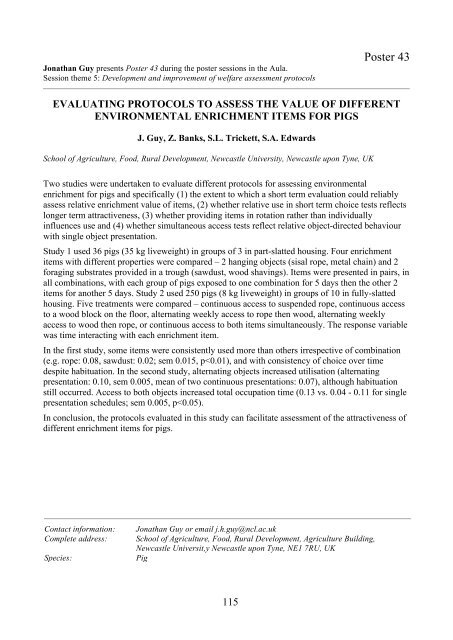Acknowledgements Book of abstracts - Publicaties - Vlaanderen.be
Acknowledgements Book of abstracts - Publicaties - Vlaanderen.be
Acknowledgements Book of abstracts - Publicaties - Vlaanderen.be
Create successful ePaper yourself
Turn your PDF publications into a flip-book with our unique Google optimized e-Paper software.
Jonathan Guy presents Poster 43 during the poster sessions in the Aula.<br />
Session theme 5: Development and improvement <strong>of</strong> welfare assessment protocols<br />
115<br />
Poster 43<br />
EVALUATING PROTOCOLS TO ASSESS THE VALUE OF DIFFERENT<br />
ENVIRONMENTAL ENRICHMENT ITEMS FOR PIGS<br />
J. Guy, Z. Banks, S.L. Trickett, S.A. Edwards<br />
School <strong>of</strong> Agriculture, Food, Rural Development, Newcastle University, Newcastle upon Tyne, UK<br />
Two studies were undertaken to evaluate different protocols for assessing environmental<br />
enrichment for pigs and specifically (1) the extent to which a short term evaluation could reliably<br />
assess relative enrichment value <strong>of</strong> items, (2) whether relative use in short term choice tests reflects<br />
longer term attractiveness, (3) whether providing items in rotation rather than individually<br />
influences use and (4) whether simultaneous access tests reflect relative object-directed <strong>be</strong>haviour<br />
with single object presentation.<br />
Study 1 used 36 pigs (35 kg liveweight) in groups <strong>of</strong> 3 in part-slatted housing. Four enrichment<br />
items with different properties were compared – 2 hanging objects (sisal rope, metal chain) and 2<br />
foraging substrates provided in a trough (sawdust, wood shavings). Items were presented in pairs, in<br />
all combinations, with each group <strong>of</strong> pigs exposed to one combination for 5 days then the other 2<br />
items for another 5 days. Study 2 used 250 pigs (8 kg liveweight) in groups <strong>of</strong> 10 in fully-slatted<br />
housing. Five treatments were compared – continuous access to suspended rope, continuous access<br />
to a wood block on the floor, alternating weekly access to rope then wood, alternating weekly<br />
access to wood then rope, or continuous access to both items simultaneously. The response variable<br />
was time interacting with each enrichment item.<br />
In the first study, some items were consistently used more than others irrespective <strong>of</strong> combination<br />
(e.g. rope: 0.08, sawdust: 0.02; sem 0.015, p
















